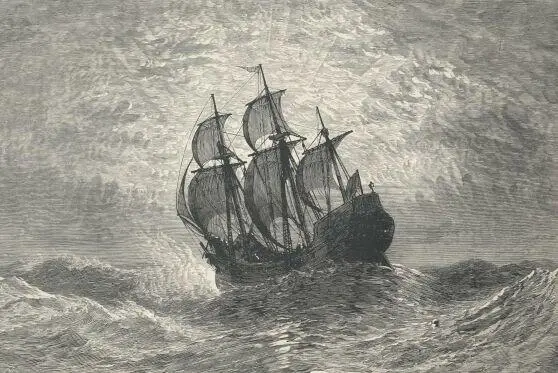Azel Ames, William Bradford & Bureau of Military and Civic Achievement
The Mayflower Voyage: Premium Edition - 4 Book Collection
4 Books in One Edition Detailing The History of the Journey, the Ship's Log & the Lives of its Pilgrim Passengers
Published by

Books
- Advanced Digital Solutions & High-Quality eBook Formatting -
musaicumbooks@okpublishing.info
2018 OK Publishing
ISBN 978-80-272-4506-2
The Mayflower Ship's Log The Mayflower Ship's Log Table of Contents
History of Plymouth Plantation
Mayflower Descendants and Their Marriages for Two Generations After the Landing
History of the Mayflower
Table of Contents Table of Contents The Mayflower Ship's Log The Mayflower Ship's Log Table of Contents History of Plymouth Plantation Mayflower Descendants and Their Marriages for Two Generations After the Landing History of the Mayflower
Table of Contents Table of Contents The Mayflower Ship's Log The Mayflower Ship's Log Table of Contents History of Plymouth Plantation Mayflower Descendants and Their Marriages for Two Generations After the Landing History of the Mayflower
Introductory
Chapter I. The Name—“May-Flower”
Chapter II. The May-Flower’s Consort the Speedwell
Chapter III. The May-Flower’s Charter and the Adventurers
Chapter IV. The May-Flower—The Ship Herself
Chapter V. The Officers and Crew of the Mayflower
Chapter VI. The May-Flower’s Passengers
Chapter VII. Quarters, Cooking, Provisions
Chapter VIII. The May-Flower’s Lading
Chapter IX. The Journal of the Ship May-Flower
Appendix
“Next to the fugitives whom Moses led out of Egypt, the little shipload of outcasts who landed at Plymouth are destined to influence the future of the world."
JAMES RUSSELL LOWELL

Table of Contents
To civilized humanity, world-wide, and especially to the descendants of the Pilgrims who, in 1620, laid on New England shores the foundations of that civil and religious freedom upon which has been built a refuge for the oppressed of every land, the story of the Pilgrim “Exodus” has an ever-increasing value and zest. The little we know of the inception, development, and vicissitudes of their bold scheme of colonization in the American wilderness only serves to sharpen the appetite for more.
Every detail and circumstance which relates to their preparations; to the ships which carried them; to the personnel of the Merchant Adventurers associated with them, and to that of the colonists themselves; to what befell them; to their final embarkation on their lone ship,—the immortal MAY-FLOWER; and to the voyage itself and to its issues, is vested to-day with, a supreme interest, and over them all rests a glamour peculiarly their own.
For every grain of added knowledge that can be gleaned concerning the Pilgrim sires from any field, their children are ever grateful, and whoever can add a well-attested line to their all-too-meagre annals is regarded by them, indeed by all, a benefactor.
Of those all-important factors in the chronicles of the “Exodus,”—the Pilgrim ships, of which the MAY-FLOWER alone crossed the seas,—and of the voyage itself, there is still but far too little known. Of even this little, the larger part has not hitherto been readily accessible, or in form available for ready reference to the many who eagerly seize upon every crumb of new-found data concerning these pious and intrepid Argonauts.
To such there can be no need to recite here the principal and familiar facts of the organization of the English “Separatist” congregation under John Robinson; of its emigration to Holland under persecution of the Bishops; of its residence and unique history at Leyden; of the broad outlook of its members upon the future, and their resultant determination to cross the sea to secure larger life and liberty; and of their initial labors to that end. We find these Leyden Pilgrims in the early summer of 1620, their plans fairly matured and their agreements between themselves and with their merchant associates practically concluded, urging forward their preparations for departure; impatient of the delays and disappointments which befell, and anxiously seeking shipping for their long and hazardous voyage.
It is to what concerns their ships, and especially that one which has passed into history as “the Pilgrim bark,” the MAY-FLOWER, and to her pregnant voyage, that the succeeding chapters chiefly relate. In them the effort has been made to bring together in sequential relation, from many and widely scattered sources, everything germane that diligent and faithful research could discover, or the careful study and re-analysis of known data determine. No new and relevant item of fact discovered, however trivial in itself, has failed of mention, if it might serve to correct, to better interpret, or to amplify the scanty though priceless records left us, of conditions, circumstances, and events which have meant so much to the world.
As properly antecedent to the story of the voyage of the MAY-FLOWER as told by her putative “Log,” albeit written up long after her boned lay bleaching on some unknown shore, some pertinent account has been given of the ship herself and of her “consort,” the SPEEDWELL; of the difficulties attendant on securing them; of the preparations for the voyage; of the Merchant Adventurers who had large share in sending them to sea; of their officers and crews; of their passengers and lading; of the troubles that assailed before they had “shaken off the land,” and of the final consolidation of the passengers and lading of both ships upon the MAY-FLOWER, for the belated ocean passage. The wholly negative results of careful search render it altogether probable that the original journal or “Log” of the MAY-FLOWER (a misnomer lately applied by the British press, and unhappily continued in that of the United States, to the recovered original manuscript of Bradford’s “History of Plimoth Plantation “), if such journal ever existed, is now hopelessly lost.
So far as known, no previous effort has been made to bring together in the consecutive relation of such a journal, duly attested and in their entirety, the ascertained daily happenings of that destiny-freighted voyage. Hence, this later volume may perhaps rightly claim to present —and in part to be, though necessarily imperfect—the sole and a true “Log of the MAY-FLOWER.” No effort has been made, however, to reduce the collated data to the shape and style of the ship’s “Log” of recent times, whose matter and form are largely prescribed by maritime law. While it is not possible to give, as the original—if it existed—would have done, the results of the navigators’ observations day by day; the “Lat.” and “Long.”; the variations of the wind and of the magnetic needle; the tallies of the “lead” and “log” lines; “the daily run,” etc.—in all else the record may confidently be assumed to vary little from that presumably kept, in some form, by Captain Jones, the competent Master of the Pilgrim bark, and his mates, Masters Clarke and Coppin.
As the charter was for the “round voyage,” all the features and incidents of that voyage until complete, whether at sea or in port, properly find entry in its journal, and are therefore included in this compilation, which it is hoped may hence prove of reference value to such as take interest in Pilgrim studies.
Читать дальше














